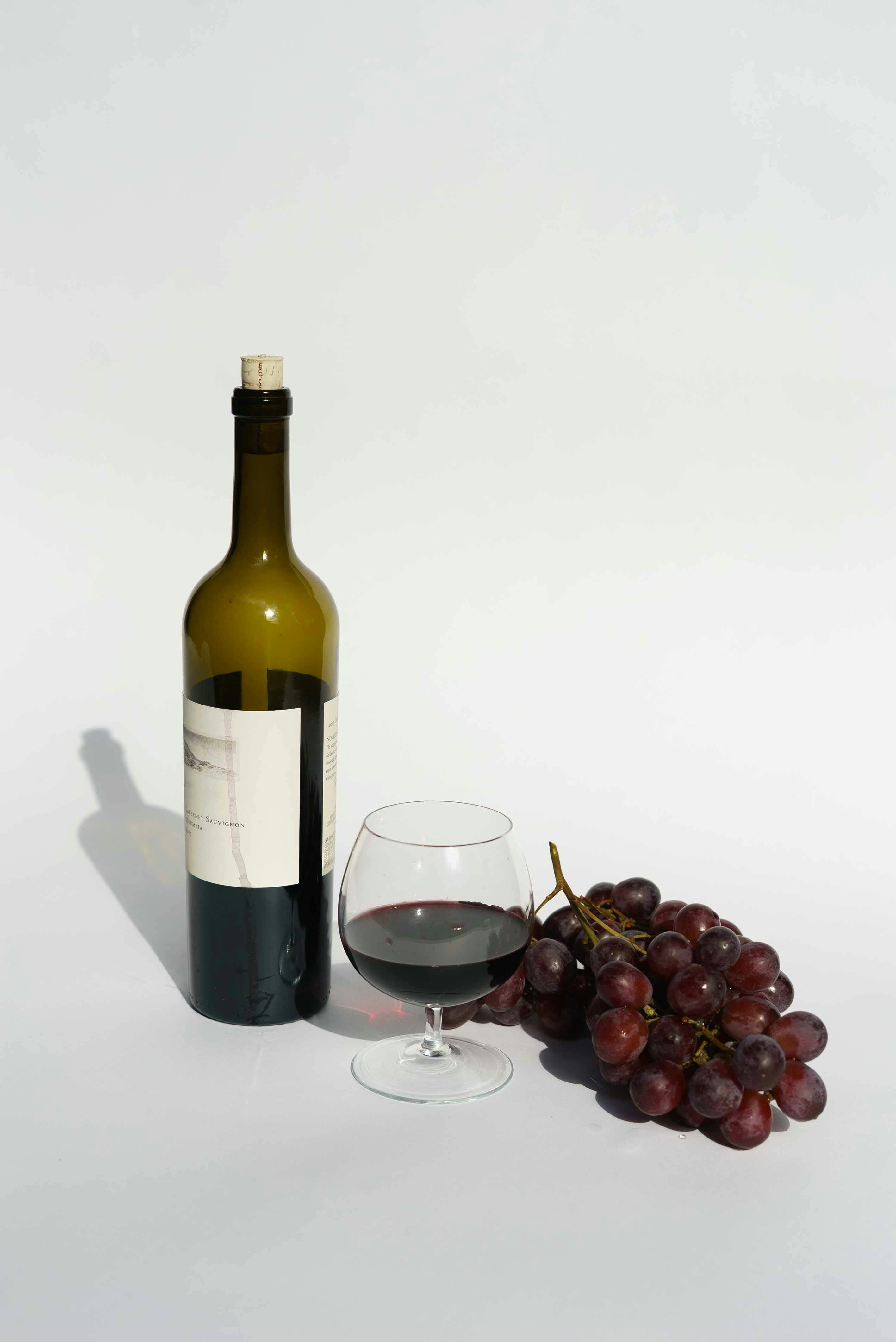Cabernet Sauvignon is one of the most popular and widely grown grape varieties in the world. This red wine has a variety of characteristics that make it one of the most celebrated wines.
Its primary flavor components are black cherry, cassis, plum, and blackberry. It also has earthy notes such as herbs, leather, and tobacco, as well as some spicy notes. Its tannins are medium to high in intensity and provide structure to the wine. Cabernet Sauvignon typically has a medium to full body with high alcohol levels and a rich mouthfeel. Its acidity is moderate to high and provides balance to the wine’s flavors.Cabernet Sauvignon is one of the world’s most popular red grape varieties. Originating from Bordeaux, France, it is now grown in almost every wine-producing region in the world. Cabernet Sauvignon is a full-bodied and robust red wine with flavors of dark fruits such as blackberry and cassis, as well as notes of tobacco, leather, and currant. It is often blended with other grapes such as Merlot, Malbec, and Petit Verdot to create complex wines with a variety of flavors. The tannins in Cabernet Sauvignon wines can be quite high and often need time to soften before they are ready to drink.
Cabernet Sauvignon is known for its aging potential and when aged correctly can develop more complex layers of flavor over time. It pairs well with food such as beef, lamb, game meats and other dishes with intense flavors. Cabernet Sauvignon wines range in price from affordable everyday options to higher end bottles that can cost hundreds of dollars.
Contents
Barossa Valley Wine Region
The Barossa Valley is one of Australia’s premier wine regions and is located in South Australia, just a short drive from Adelaide. It is renowned for its Shiraz, Cabernet Sauvignon, and Semillon wines, as well as its unique terroir. The area has a diverse range of soils and microclimates, which make it ideal for producing quality wines. There are more than 80 wineries in the region, many of which have been family-owned for generations. The region also boasts some of the oldest vineyards in the world, with some vines dating back to the 1840s.
Climate
The Barossa Valley has a temperate climate with hot summers and mild winters. Average daily maximum temperatures range from 16°C (61°F) in July to 28°C (82°F) in January. The area also experiences an abundance of sunshine throughout the year – an average of 8 hours per day – which helps to ripen the grapes used for making wine. Rainfall is fairly consistent throughout the year but is highest during winter months, usually between April and October. The combination of warm days and cool nights helps to ensure that grapes ripen slowly while retaining their natural acidity, producing wines with great character and complexity.
Color
Cabernet Sauvignon is known for its deep, dark color. Typically, Cabernet Sauvignon will range from a deep purple to a ruby red. The darker the color, the more intense the flavor. On the other hand, lighter hues are indicative of a younger wine that has not been aged for long.
Aroma
Cabernet Sauvignon is known for its strong aroma with notes of berry, currant, and cassis. It also has aromas of herbs and oak from barrel aging. Some bottles may have hints of tobacco or coffee-like aromas as well.
Flavor
Cabernet Sauvignon carries bold flavors of dark fruit like blackberry and cherry, along with notes of black pepper and thyme. Aging can also add flavors such as leather or tobacco to the mix. It is usually dry with high acidity and moderate tannins, making it a great choice for food pairing.
Characteristics of Cabernet Sauvignon Wine
Cabernet Sauvignon is a type of wine made from the Cabernet Sauvignon grape variety. It is one of the world’s most widely recognized red wine grape varieties and is grown in nearly every major wine producing country. Cabernet Sauvignon wines are known for their full body, high tannin levels, and intense aromas and flavors. The most common characteristics of Cabernet Sauvignon include:
- Deep red color
- Medium to full-bodied
- High tannin levels
- Intense aromas that can include blackberry, black currant, cedar, tobacco, eucalyptus, mint, and bell pepper
- Flavors that can include blackberry, plum, cherry, cassis, tobacco, cedar, violet, clove and mocha
- A long finish that can have hints of oak or chocolate.
Overall Cabernet Sauvignon wines are powerful yet elegant with high acidity which makes them food friendly. They pair well with a variety of dishes including grilled meats like steak or lamb as well as dishes with strong flavors like tomato-based sauces. They also age well when stored properly in cool temperatures and away from light sources.
Acidity and Tannins in Cabernet Sauvignon
Cabernet Sauvignon is a full-bodied red wine that features a complex flavor profile. It is composed of several elements, including acidity and tannins. Acidity plays an important role in the overall taste of Cabernet Sauvignon, as it provides balance to the rich fruitiness of the wine. Tannins, on the other hand, provide structure and complexity to the wine. Both acidity and tannins are integral components in creating a quality Cabernet Sauvignon.
Acidity in Cabernet Sauvignon gives it a crisp, dry finish that helps balance out its intense flavor profile. It also helps to preserve the flavors of the wine after it has been aged. The amount of acidity in a Cabernet Sauvignon varies depending on where it is grown and how long it has been aged. Typically, wines from cooler climates will have higher levels of acidity than those from warmer climates.
Tannins are compounds found in grape skins and seeds that give Cabernet Sauvignon its distinctive structure and complexity. Tannins help to preserve the color and flavor of the wine as well as add structure to its body. They also contribute to Cabernet’s age-worthiness by helping to protect it from oxidation over time. The amount of tannin present in a Cabernet Sauvignon depends on how long it has been aged, with longer aging periods resulting in more tannin development.
When making a quality Cabernet Sauvignon, winemakers strive for optimal levels of both acidity and tannin for balance as well as age-worthiness. The combination of these two elements helps create wines that are complex yet approachable with flavors that linger on your palate long after you take your last sip.

Cabernet Sauvignon Food Pairings
Cabernet Sauvignon is known for its rich, full-bodied flavor and its deep color. This makes it the perfect accompaniment to rich, savory dishes like beef and lamb. It can also be paired with bold flavors like blue cheese, mushrooms, and olives. For something a bit lighter, pair Cabernet Sauvignon with poultry or pork dishes. To bring out the best of both the food and wine, try pairing Cabernet Sauvignon with dishes that have similar flavors, such as tomato-based dishes or herbal sauces.
When it comes to cheese pairings, Cabernet Sauvignon pairs well with a variety of cheeses such as Gruyere, Cheddar and Gouda. For something sweet, pair Cabernet Sauvignon with dark chocolate or desserts that have dark berry compotes such as blackberry cobbler or cherry pie.
Overall, when pairing Cabernet Sauvignon it’s important to choose dishes that will complement its bold flavor profile. The key is to play off the wine’s natural characteristics while still allowing the food to shine through. With a little bit of experimentation and exploration you can find the perfect pairing for your next meal!
Styles of Cabernet Sauvignon Wine
Cabernet Sauvignon is one of the most popular and widely planted grapes in the world. It’s a red grape variety that originates from Bordeaux, France. Cabernet Sauvignon is known for its intense tannins and dark fruit flavors, making it one of the more complex wines to produce. Depending on where it’s grown, the style of Cabernet Sauvignon can vary greatly.
In general, there are three main styles of Cabernet Sauvignon: traditional French-style, California-style and New World-style. Each style has its own unique characteristics and flavor profiles that make them stand out from each other.
Traditional French-style Cabernet Sauvignon is made with a focus on balance and restraint. The wine typically has high acidity and low tannins with notes of black currant, cassis, tobacco, leather, graphite and cedar. This style is usually aged in oak barrels for 12 to 18 months or sometimes longer.
California-style Cabernet Sauvignon is made with a focus on ripe fruit flavors and often has higher alcohol levels than traditional French-style wines. This style typically has intense aromas and flavors of dark fruits such as blackberry, blueberry and plum along with notes of chocolate, espresso and vanilla from oak aging.
New World-style Cabernet Sauvignon is often produced in regions outside Europe such as Australia, South Africa or Chile where growing conditions are different than in France or California. This style can have a wide range of flavors from red fruits to black fruits along with herbal or floral notes depending on where it’s grown. The tannins tend to be softer than in other styles due to the climate conditions which allow for earlier harvesting dates.
Understanding the Aging Potential of Cabernet Sauvignon Wine
Cabernet Sauvignon is a popular and highly regarded wine, but it also has unique aging characteristics. To understand the potential of Cabernet Sauvignon as an aged wine, it is important to consider its structure, acidity, tannins, and other factors that can influence its aging potential.
Cabernet Sauvignon is typically a full-bodied red wine with intense flavors of dark fruit and spice. It has firm tannins that can soften with age and acidity that tends to mellow out over time. The flavor profile of Cabernet Sauvignon also becomes more complex over time. This makes it a great candidate for aging in the bottle.
When considering how long to age Cabernet Sauvignon, it is important to remember that not all wines are created equal. Some vintages may be more suitable for aging than others due to their structure or character. Generally speaking, Cabernet Sauvignon can be aged for up to 10 years or more when stored in optimal conditions. The best way to determine if a bottle is ready to drink is to taste it.
When storing Cabernet Sauvignon for aging, it should be kept in a cool, dark place away from direct sunlight and vibration. Temperature fluctuations should be avoided as much as possible as they can lead to off-flavors in the wine over time. Additionally, bottles should be stored on their sides so that the cork remains moist and airtight.
Aging Cabernet Sauvignon can be a rewarding experience for those who are patient enough to wait for it to reach its peak drinking age. Knowing how best to store this type of wine and understanding its structure and flavor profile can help you select bottles that will have the most potential for aging in your cellar.

Conclusion
Cabernet Sauvignon is a full-bodied red wine with intense notes of blackcurrant, cedar, and pencil shavings. Its texture is often tannic, yet the finish is smooth and balanced. It pairs well with many foods, including grilled meats, rich pasta dishes and hard cheeses. Cabernet Sauvignon can be enjoyed on its own or in a blend. With its unique flavor profile and versatility, it is no wonder why Cabernet Sauvignon has become one of the most popular wines in the world.
Cabernet Sauvignon has a great deal to offer both casual drinkers and connoisseurs alike. It has an appealing robustness that will please any palate while still maintaining complexity and balance. Whether you are looking for an everyday wine to enjoy or something special to pair with food, Cabernet Sauvignon should be at the top of your list.
0 Comments